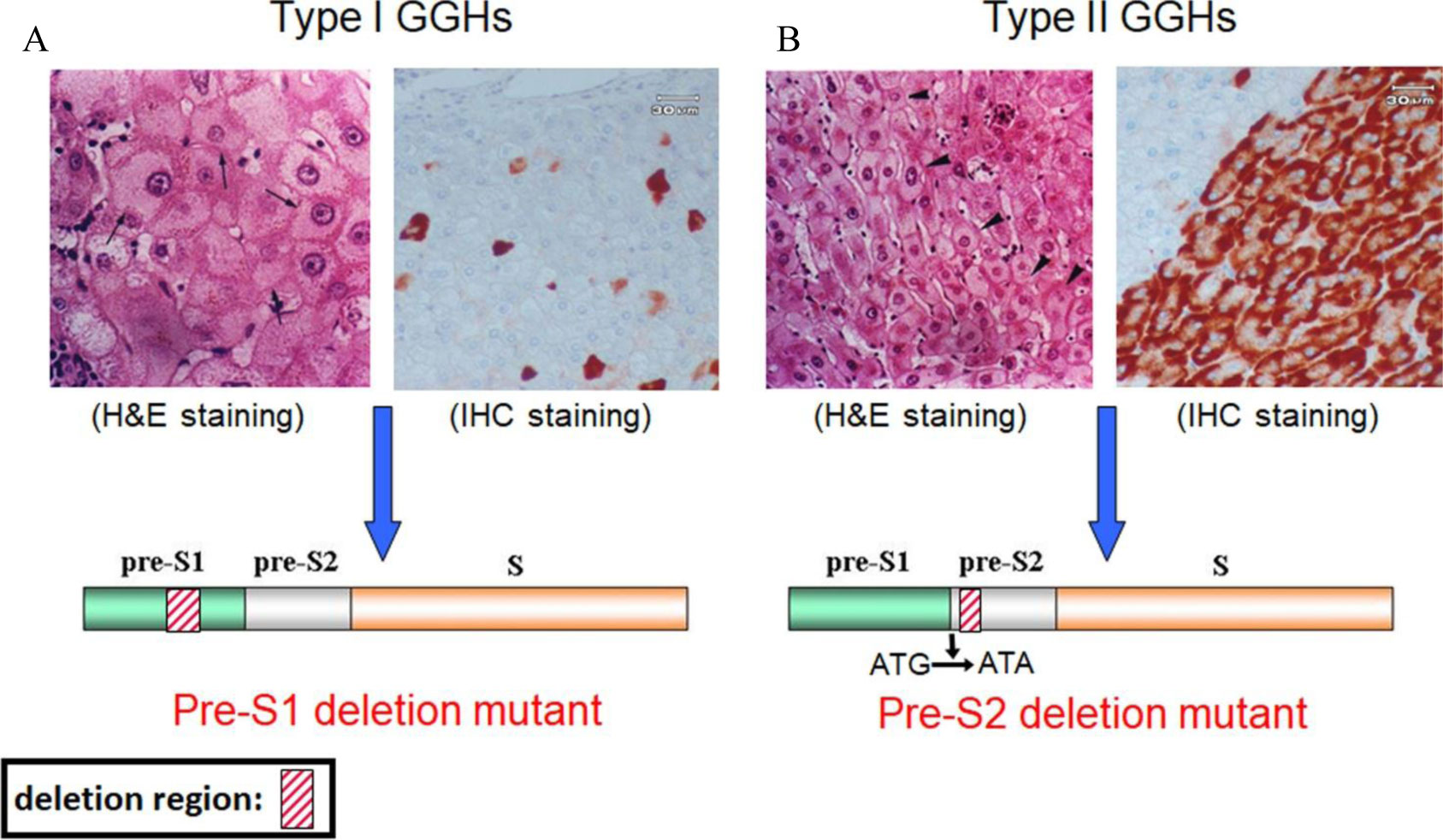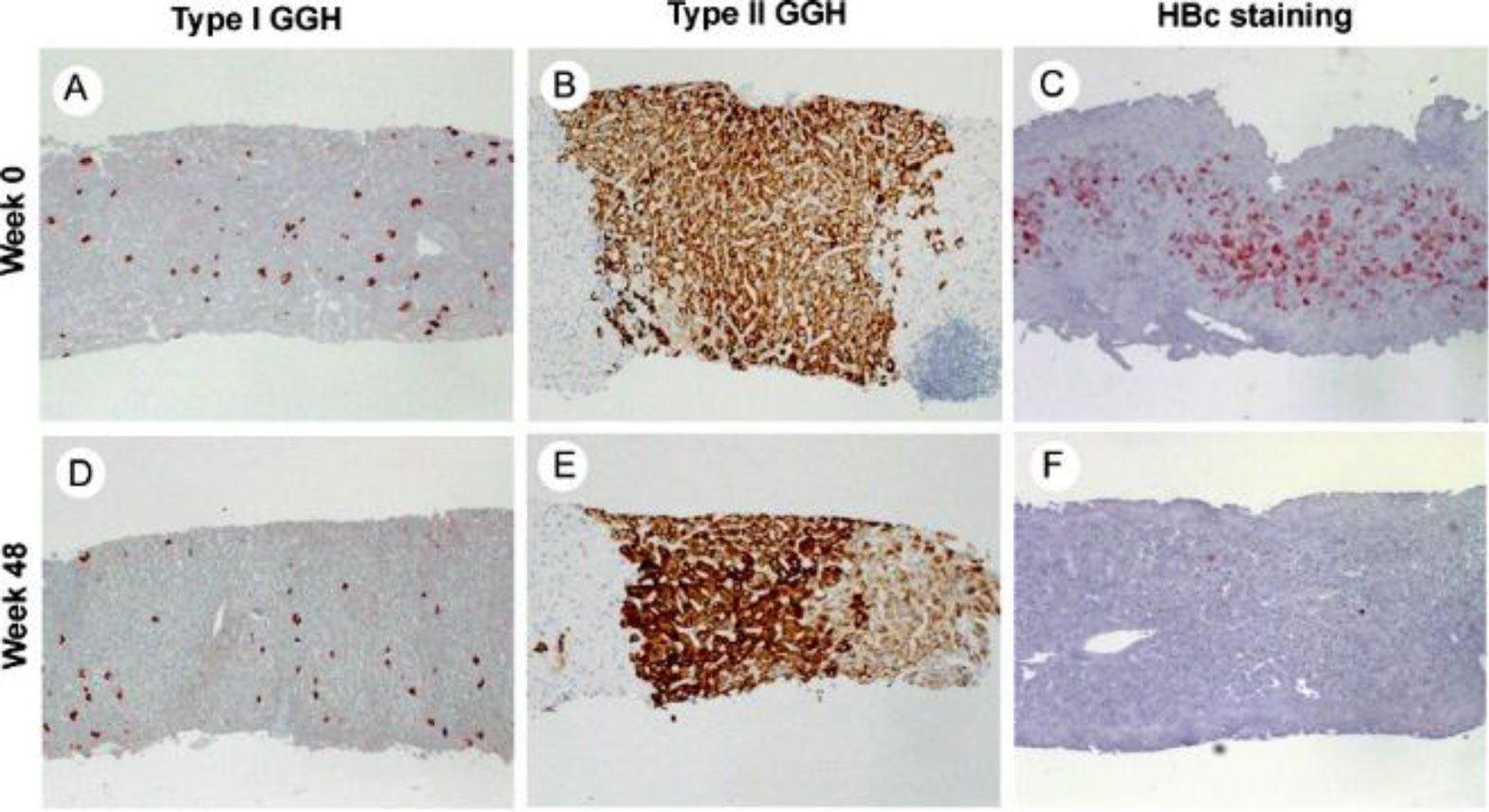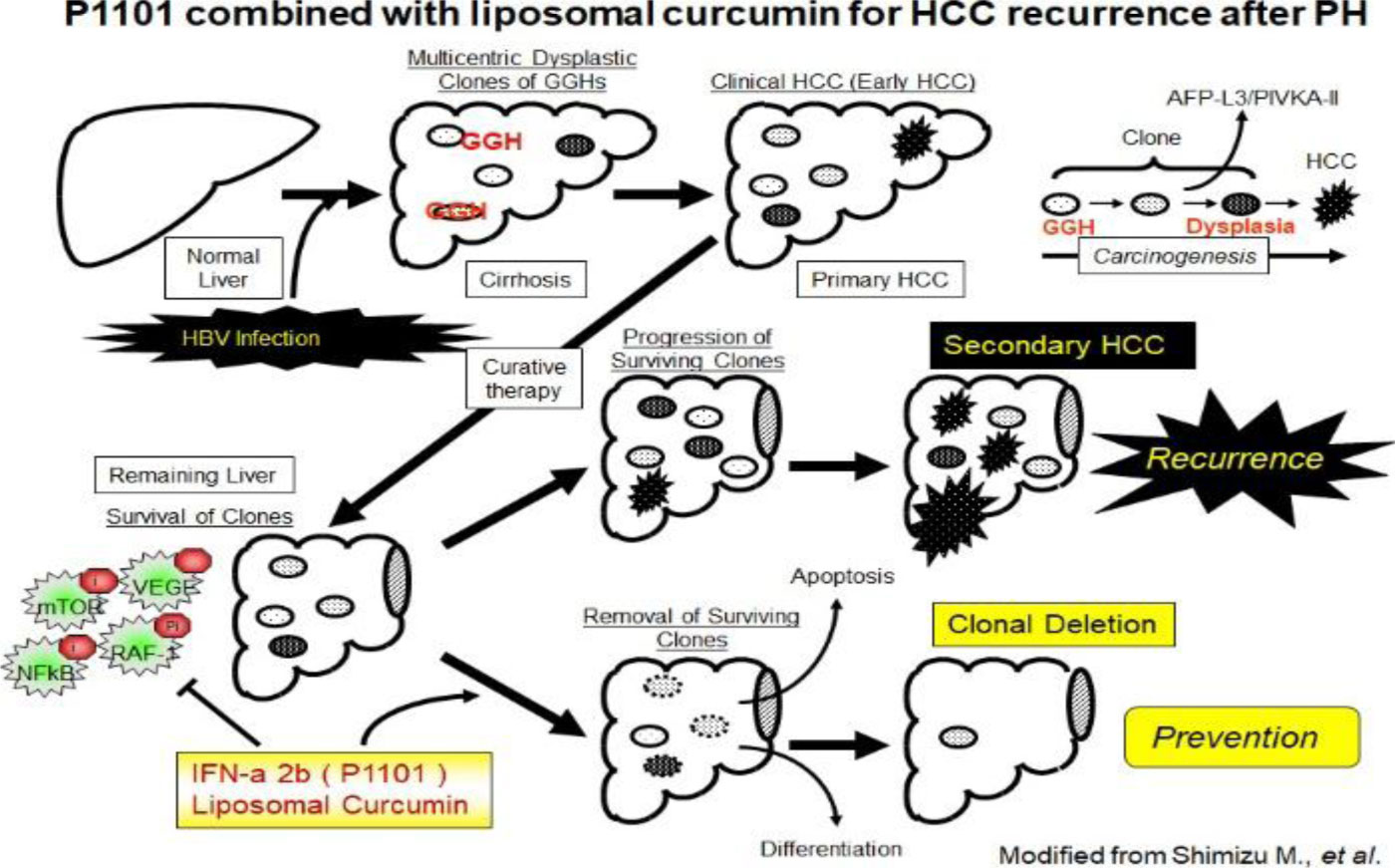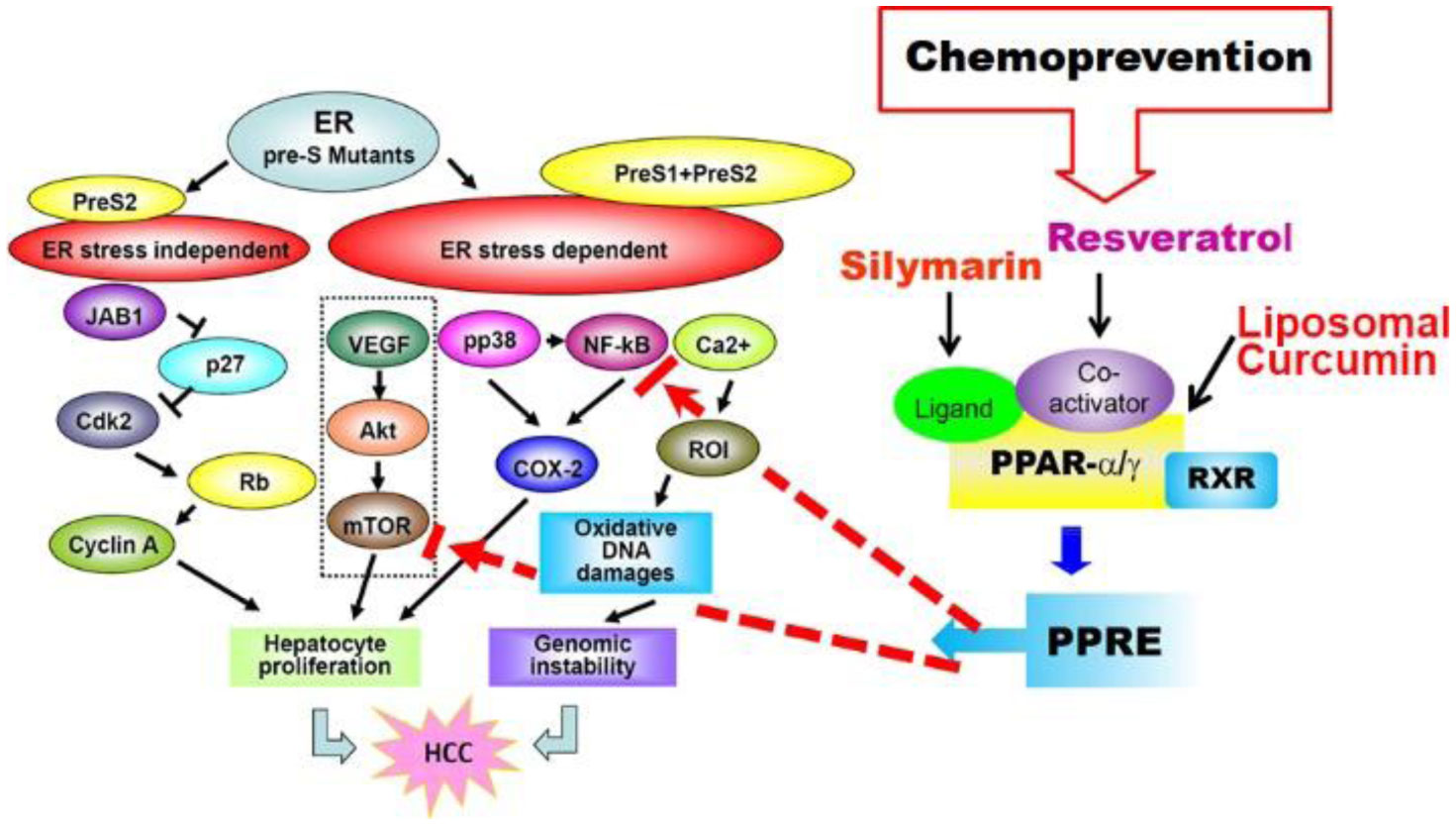1. Historical background of ground glass hepatocytes (GGHs)
In the early 1970s, Hadziyannis and Popper first recognized the hepatitis B virus (HBV) surface antigen in “ground glass hepatocytes (GGH)” of chronic HBV carriers (Figure 1, summarized results from Reference 7, 10 and 18) [1,2]. The identification of GGH has become a major biomarker for chronic HBV infection. GGHs are characterized by an abundance of endoplasmic reticulum (ER), among which viral particles of surface antigens accumulate [3,4]. It is the overloaded ER that makes the cytoplasms of hepatocytes become “foggy” or “glassy”. After the introduction of immunohistochemistry, a series of studies demonstrated that different types of GGH correlated to the different replicative stages of chronic HBV infection [5,6]. Two major types of GGHs are identified and designated later by us as types I and types II GGHs [7]. Type I GGH are usually scattered singly in the hepatic lobules with the expression of dense homogeneous or “inclusion-like” pattern of surface antigens (Figure 1A). This type of GGH usually occurs at the early carrier stage or in patients with active diseases, frequently co-expressed with a nuclear or cytoplasmic core antigen [5,8,9]. Type II GGHs express a unique pattern of surface antigens at the cell margin or periphery (Figure 1B). Most interestingly and importantly, type II GGHs consistently cluster in nodules with a diameter of up to 0.2 cm and usually occur at the advanced or anti-HBe-positive stages, and are frequently associated with cirrhosis or hepatocellular carcinoma (HCC).
2. Identification of pre-S deletion mutants in GGH
Besides recognizing as the biomarker of chronic HBV infection, the biologic and pathologic significance of GGHs are not well described until 2001 when our laboratory first proposed that type II GGH may represent clonally-proliferated, adenomatous, or preneoplastic lesions of HCC based on the clustering growth pattern of type II GGHs [10,11]. By dissecting type II GGHs, we were surprised to find that type II GGH consistently harbored pre-S deletion mutants with in-frame deletions over the pre-S2 regions (predominantly, nt 2-55 or 4-57) with or without point mutations at the start codon (ATG-ATA) of the S promoter. The point mutation at the start codon of the S promoter could lead to the defective synthesis of the middle surface antigen. It is interesting to note that the deletion site at the pre-S2 region coincides with the epitope of the cytotoxic T-cell and neutralization responses, and suggests that the pre-S2 deletion mutants may represent an immune escape mutant which prevails at the advanced phase of chronic HBV infection [12,13]. Different from type II GGHs, type I GGHs contain entirely different pre-S mutants with variable deletions over the pre-S1 regions, and hence designated pre-S1 deletion mutant.
The emergence of pre-S deletion mutants occurs during the natural course of HBV infection, possibly due to selective pressure by the immune system [14,15]. The frequencies of pre-S mutations increased successively at the different stage of chronic HBV infection. In a meta-analysis study, the summarized results showed that pre-S mutants were detected in around 10% of asymptomatic HBsAg carriers, 20% of patients with chronic hepatitis B, 35% of patients with liver cirrhosis and 60% patients with HCC [16]. The pre-S2 deletion mutants are more frequently detected in anti-HBeAg-positive patients and in patients with HCC than in HBeAg-positive patients [17,18,19]. The ratio of pre-S mutant clones related to wild type in serum also accumulates, as it was 6.4% at high replicative phase, 13% at intermediate phase, and 37.5% at low or nonreplicative phase [18]. Therefore, pre-S2 mutants represent a significant proportion of viruses in advanced stage chronic HBV patients [20,21].
3. ER stress signals, oxidative DNA damage, and transforming capabilities induced by pre-S mutants: GGHs represent the precancerous lesions of HCC
The demonstration of mutated pre-S mutants in ER confers the new biological significance of GGHs in addition to its being a histological marker of chronic HBV infection. Inductions of ER stress-related chaperones were detected in GGHs carrying pre-S mutants in patients with chronic hepatititis B, suggesting that these GGHs were under the condition with persistent ER stress [7,22]. Notably, long-term persistence of unfolded protein response (UPR) and ER stress has been documented in many different human cancers (see a comprehensive review in [23]). This implies that persistent ER stress may have certain tumor promoting roles toward malignant transformation. In this regard, many downstream signal cascades of ER stress were activated by pre-S mutants, as shown in different cell-based models, transgenic mice models, and in clinical specimens. The expression of pre-S mutant large surface antigen was shown to induce ER stress-associated chaperones (GRP78/94), activation of JNK, expressions of cyclooxygenase-2 (COX-2) and inflammatory cytokines, as well as oxidative DNA damages [7,24,25]. In addition, ER serves as an essential organelle in eukaryotic cells for calcium storage and release, as well as cellular secretion. Stress condition in the ER was shown to interrupt calcium homeostasis through affecting store-operated calcium entry (SOCE). This was observed specially in the case of type-II GGHs carrying HBV pre-S2 mutants [26]. The loss of calcium homeostasis in ER induces dimerization of the stromal interaction molecule-1 (STIM1) and thereby provokes its recruitment to the plasma membrane for the subsequent interaction with a calcium release-activated calcium modulator 1 (Orai1). The store-operated calcium entry/SOCE orchestrates the interaction between STIM1 and Orai1 and thereby triggers calcium entry from extracellular source [26,27]. This event will ultimately increases the overall cytosolic calcium in order to refill ER calcium storage. Notably, the consequence of calcium imbalance in hepatocytes involves the hyperactivation of calpain protease and the induction of calpain-cleaved substrates including cyclin A. Interestingly, the cleaved cyclin A is more stable than its full-length cunterpart. As a result, the protein complex containing cleaved cyclin A and Cdk2 promotes hyperduplication of centrosomes and subsequently provokes hepatocarcinogenesis [28,29].
Another obvious oncogenic effect associated with HBV-related prolonged ER stress is the induction of DNA damages in transgenic mice carrying HBV surface antigens or pre-S mutant proteins [30,31,32]. Increased oxidative DNA damages and DNA double-stranded breaks were detected in type II GGHs and in hepatocytes expressing pre-S2 mutants [24,31,32]. A recent study also showed that HBV pre-S2 mutant may specifically inhibited DNA double-stranded repair by blocking nuclear transport of an essential DNA repair factor NBS1, leading to an overall genomic instability [31]. Taking together of these findings, it is plausible to predict that hepatocytes carrying pre-S2 mutants may suffer constant ER stress. Accordingly, these pro-oncogenic signals related to ER stress are constantly activated in type II GGHs, making it more vulnerable to oncogenic transformation.
4. The transgenic mice model of pre-S2 mutant: Pre-S2 mutant as a new viral oncoprotein
HBV transgenic mice have been produced either with complete HBV genomes that can support viral replication or with selected viral genes, including three surface genes, HBx, core, and precore genes [33]. The expression of large surface antigens in transgenic mice has been shown to be cytopathic and could lead to liver injuries, regenerative hyperplasia, chronic inflammation, oxidative DNA damage, and eventually progress to HCC [34,35,36,37]. In our laboratory, the transgenic mouse model with pre-S2 deletion mutant was created, and the dysplastic change of hepatocytes was demonstrated with HCC formation at 2 years of age [36]. In the studies of the transgenic mouse model using pre-S2 mutants, the hepatic lobules usually revealed minimal inflammatory and necrotic activities, the findings similar to the liver pathology in the non-tumorous part of human HCC. These results provide evidence for a direct role of HBV in carcinogenesis and highlight the potential role of the pre-S2 mutant protein as a viral oncoprotein. Recent studies on the evolutional pathology of the transgenic mice with pre-S2 deletion mutant revealed series of histopathologic changes of endoplastic reticulum and mitochondria of the hepatocytes which evolved into HCC [38]. These overall results provide evidence for a direct role of HBV in carcinogenesis and highlight the potential role of the pre-S2 mutant protein as a viral oncoprotein.
5. Development of a DNA chip and ELISA kit to detect pre-S2 mutants in serum as the predictive biomarker of HCC
To efficiently detect pre-S deletion mutants in serum, we have successfully developed the oligonucleotide pre-S gene chip to detect the pre-S deletion mutants in sera. The pre-S gene chip contains 42 DNA probes that target the pre-S region of the LHBS gene, offering a highly sensitive and specific method for the deletion of pre-S deletion mutants with a short turnaround time (≤ 3 days) [39]. Screening the pre-S deletion mutants revealed interesting findings that the detection rate of pre-S mutants was relatively low (7%) in the sera of patients with acute exacerbation of chronic HBV infection but gradually increased at the later periods of chronic HBV infection; i.e., 37% in advanced stage of chronic HBV carriers, and as high as 60% in HCC patients [39]. Combined detection of pre-S mutants and other markers of HBV replication such as HBeAg and viral loads is believed to offer a reliable method for predicting HCC risks in chronic HBV carriers.
6. The current challenge of chronic HBV therapy: Sustained serum HBsAg and liver GGHs after antiviral treatment
Currently, oral nucleos(t)ide analogues (NAs) are the standard treatment of chronic hepatitis B. NAs can rapidly suppress HBV replication and decrease HBV viral load within the first year in the majority of patients. A significant decrease of HBc staining in liver was also observed [40]. Due to decrease of viral replication, liver necroinflammation activity and fibrosis are also gradually improved. In one study, long-term entecavir therapy for a least 3 years could render ≥ 2-point decrease in the Knodell necroinflammatory score and no worsening of the Knodell fibrosis score in 96% of patients. Reversion of fibrosis with ≥ 1-point improvement in the Ishak fibrosis score could be observed in 88% of patients [41]. The incidence of HCC was significantly lower in the NA-treated patients than in untreated patients (3.3 vs. 9.7 per 100 person years) [42]. The six-year HCC recurrence rate after surgery was also significantly decreased (treated 45.6% vs. untreated 54.6%; p < 0.001) [43]. The decrease of HCC incidence or recurrence by NA treatment may be through the suppression of viral load and the decrease of liver injuries and subsequent regeneration. However, cumulating evidence revealed that there are still high incidence of HCC development with up to 45% of patients still suffering from HCC recurrence in five years postsurgery despite anti-HBV therapy. Our previous study clearly showed that NA treatment did not effectively inhibit pre-S2 mutants in serum, and type I GGH and type II GGH in liver. A significant decline of type I (p = 0.049) and type II GGH (p = 0.029) could only be observed after long duration of treatment (median duration: 4.3 years) (Figure 2, original data from Reference 40). The persistence of type II GGHs in the non-tumor part of liver was an independent predictor of HCC recurrence after surgery [40,44]. Although NAs targets HBV polymerase and HBV replication, it does not have significant effect on cccDNA and integrated HBV DNA. Pre-S2 mutant HBs can still be produced by using cccDNA and integrated HBV DNA which potentially drive de novo HCC recurrence and partly explain the residual risk of HCC recurrence under NA treatment. In line with the persistent GGH, the serum HBsAg level was also declined slowly under NA treatment. The median duration of therapy to achieve a 1 log 10 IU/ml decrease was 6.6 to 8 years. Based on the kinetics, it was estimated that more than 10-30 years were needed for NA responders to achieve HBsAg loss [45]. Persistent HBsAg would impair antiviral activity of T cells by immune exhaustion. Interferon has been shown to target cccDNA, suppress viral replication and enhance host immunity against the virus. However, interferon has an overall viral response rate of 30% and only about 8-10% of cases could achieve HBsAg loss [46]. Therefore, intrahepatic GGHs, persistent serum HBs and pre-S mutant, cccDNA and integrated DNA remain the unsolved challenges for HBV treatment.
7. Development of novel therapy for HBV-related HCCs targeting at ground glass hepatocytes: The new era of antivirals and HCC drug development
Because of the sustained presence of HBsAg in serum after NA anti-virals, new or second generation drug development is currently developing to achieve functional cure (sustained viral suppression and HBsAg loss), complete cure (cccDNA elimination), and HCC prevention. Several phase II drugs to combine anti-virals with immunomodulators, agents for DNA damage or telomerase, and siRNA to interrupt the transcription of integrated HBV DNA or cccDNA are under development. Lymphotoxin-beta receptor activation and anti-host DNA repair factors may be potential therapeutic alternatives to target cccDNA. RNA interference, nuclear acid polymers and immune-mediated destruction may be potential approach to target HBs and pre-S mutants. Integrated HBV DNA probably could be targeted by genome-editing techniques.
In high risk (serum pre-S mutants-positive or tissue GGHs present) patients of chronic HBV infection, besides the drug development described above, we choose to explore the potential use of natural products for HCC chemoprevention targeting at the pre-S mutant-induced ER stress signal pathway or metabolic pathway initiated by mTORC1 cascade (Figure 3, modified figure from Shimizu M et al, 2012, Journal of Carcinogenesis). By analysis of metabolic gene expression profiles in transgenic mice livers and in vitro culture system harboring pre-S2 mutant protein, we observed that mTOR exhibited a significant role in the metabolic switch toward increased glycolysis and lipid accumulation in HCC tissues. We demonstrated that pre-S2 mutant could activate two mTOR-induced metabolic pathways, one involving Yin Yang 1 (YY1), c-myc and glucose transporter 1 (GLUT1) to upregulate aerobic glycolysis, and the other involving sterol regulatory element-binding protein-1 (SREBP-1) and acyl-CoA lyase (ACLY) to promote de novo lipid biosynthesis [47]. The activation of mTOR-dependent metabolic signaling cascades was further validated in human HBV-related HCC tissues.
Among the natural products, liposomal curcumin (Meriva®), silymarin and resveratrol represent potential candidate products because of their popular and long-term usage in human communities [48]. Although curcumin showed significant in vitro effects on the inhibition of NF-κB, mTOR and PPAR (peroxisome proliferator activated receptor), its low bioavailability makes curcumin impossible to be developed as a chemopreventive agent until recent application of new formulation as liposomal curcumin. A phase II clinical trial to combine liposomal curcumin (Meriva®) with pegylated interferon P1101 and anti-virals is now designed for the reduction of HCC recurrence after surgical resection (Figure 3). Silymarin, the active component silibinin, has been evaluated clinically in the treatment of hepatitis and liver damage because of its anti-inflammation and anti-oxidant effects [48,49]. Resveratrol has been verified to be effective to prevent cancer development at various stages of carcinogenesis including initiation, promotion, tumor invasion and metastatsis [50,51,52]. Importantly, resveratrol is also a promising product for metabolic syndrome mediated through mTOR inhibition and upregulation of PPARs and PGC-1α [53,54]. The combination of silymarin and resveratrol could target on the major signal pathways induced by pre-S2 mutants (Figure 4, original figure from Su IJ et al, 2014, Journal of Biomedical Science). The data revealed a remarkable effect of this combined product on reducing lipid metabolism and decreasing the incidence of HCC development in transgenic mice harboring HBx and pre-S2 mutant [55]. Further studies or clinical trials are needed to validate the effect of the natural products, with or without the combination of antivirals in chemoprevention or therapy of HBV-related HCCs.
Acknowledgements
This study was supported by grants from National Health Research Institutes, Taiwan (Dr Su and Dr Huang).
Conflict of interest
The authors declare no conflict of interest in this paper.










 DownLoad:
DownLoad: 









